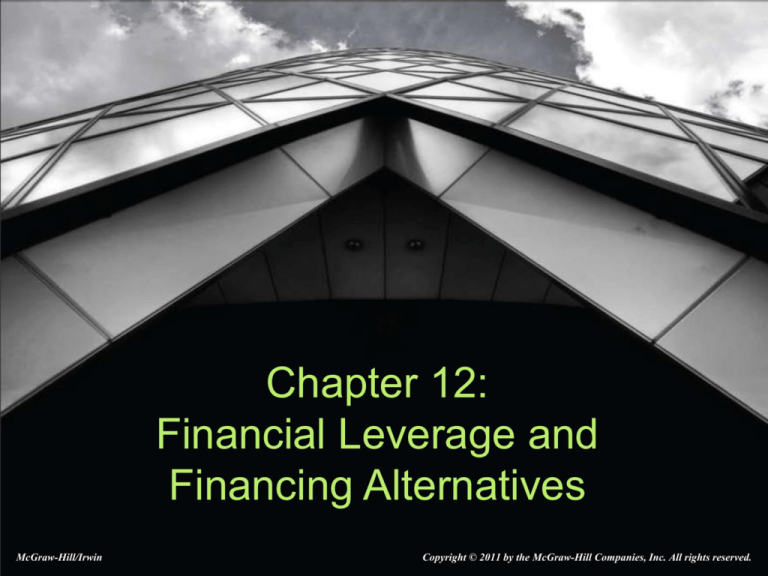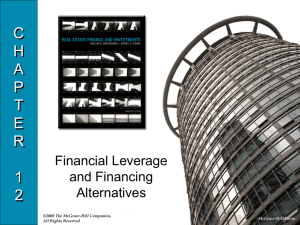
Chapter 12:
Financial Leverage and
Financing Alternatives
McGraw-Hill/Irwin
Copyright © 2011 by the McGraw-Hill Companies, Inc. All rights reserved.
Financial Leverage
What is financial leverage?
– Benefit of borrowing at a lower interest rate
than the rate of return on the property.
Why use financial leverage?
– Diversification benefits of lower equity
investment
Can invest in other property
– Mortgage interest tax benefit
– Magnify returns if the return on the property
exceeds the cost of debt
12-2
Financial Leverage: Before Tax
Positive Financial Leverage
– Returns are higher with debt
Unleveraged BTIRR
– Return with no debt
If unleveraged BTIRR > interest rate on
debt
– The BTIRR on equity increases with debt
– There is positive financial leverage
12-3
Financial Leverage: Before Tax
Equation 1:
BTIRRE= BTIRRP + (BTIRRP – BTIRRD)(D/E)
– BTIRRE = Before-Tax IRR on equity invested
– BTIRRP = Before-Tax IRR on total investment
in the property (debt and equity)
– BTIRRD = Before-Tax IRR on debt (effective
cost including points)
– D/E =Debt/Equity ratio
12-4
Financial Leverage: Before Tax
Equation 1 shows that as long as:
– BTIRRP > BTIRRD, then BTIRRE > BTIRRP
– This implies increasing D/E will yield positive results
But the use of debt is limited
– Debt coverage ratio restrictions
– Higher loan to value ratios are riskier to lenders. If the
LTV is too high, the interest rates will be higher.
– Higher debt levels increase risk to equity investor
12-5
Financial Leverage: Before Tax
Negative Financial Leverage
– If BTIRRD > BTIRRP, then BTIRRE < BTIRRP
– The use of debt reduces the return on equity.
12-6
Financial Leverage: After Tax
Equation 2:
ATIRRE= ATIRRP + (ATIRRP – ATIRRD)(D/E)
– ATIRRE = After-Tax IRR on equity invested
– ATIRRP = After-Tax IRR on total investment in
the property
– ATIRRD = BTIRRD (1-t)
After-Tax IRR on debt (effective cost after taxes
including points)
– D/E =Debt/Equity
12-7
Financial Leverage: After Tax
Break-even interest rate
– Maximum interest rate before negative financial
leverage
ATIRRD= ATIRRP
ATIRRD= BTIRRD(1-t)
BTIRRD= ATIRR D =
1 t
ATIRR P
1 t
Risk considerations
Break-even interest rate is not affected by LTV.
12-8
Underwriting Loans
Market Study and Appraisal
Borrower Financial Statements
– Nonrecourse clause. If nonrecourse, it’s sort
of like the loan has a built in put option for the
borrower.
Loan to Value Ratio
Debt Coverage Ratio
12-9
Underwriting Loans
Possible Mortgage Covenants
– Approval of new leases by lender
– Approval of lease modifications by lender
– Approval of construction by lender
– Borrower submits periodic updates of
financials
12-10
Underwriting Loans
Possible Mortgage Covenants
– Annual property appraisal
– Notify lender of legal problems
– Notify lender when correcting property defects
– Lender has right to visit
The lender’s goal is to insure that after the
loan is closed, the value and incomeproducing ability of the asset is not impaired.
12-11
Underwriting Loans
Lockout Clause
– Prohibits prepayment of loan for a specified period of
time
Yield Maintenance Fee
– Guarantees a yield to the lender after a lockout period
expires
Sometimes the fee is fixed as a percentage of
the outstanding balance. This percentage may
also vary based on the remaining term of the
mortgage.
12-12
Alternative Financing Structures
Mismatch between property income in the
early years and constant payment loans
Income is expected to increase
– Inflation effects
– New building not fully leased when loan is
made
– Leases may be below market
Results in different loan structures
12-13
Alternative Financing Structures
Equity Participation Loans
– Lower interest rate from lender
– Lender shares in property cash flow
Percent of PGI, NOI, or BTCF, etc.
– Lender motivations
Guaranteed minimum return and some protection
of real return
– Investor motivations
Easier to meet debt service requirements
12-14
Alternative Financing Structures
Sale-Leaseback of Land
– Own building and lease land from a different investor
Motivations
–
–
–
–
100% financing possible
Lease payments are tax deductible
Building is depreciable; land is not
Possible purchase option at end of lease. If option is
not present, the investor may not be able to buy back
the land.
12-15
Alternative Financing Structures
Interest Only Loans: “Bullet Loans”
– No amortization for a specified period
– Balloon payment or amortization afterward
Accrual Loans
– Negative amortization
– Pay Rate
Interest rate used to calculate loan payment
– Accrual Rate
Interest rate used to calculate the interest charged
– Accrual loans can be dangerous for a borrower as the
amount owed becomes greater over time.
12-16
Alternative Financing Structures
Structuring the payment for a targeted
debt coverage ratio
– Not always fully amortizing
– Balloon payment
Convertible Mortgage
– Lender has an option to convert debt to equity
Mezzanine Loan
Preferred Equity
12-17









